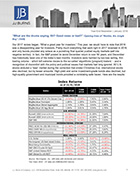“Hush, hush, hush / Here comes the Bogeyman! / Don’t let him come too close to you / He’ll catch you if he can” 20th-century children’s song, “Hush, Hush, Hush, Here Comes the Bogeyman”
What happens when the can has been kicked to the end of the road? The piper demands to be paid? Peter demands repayment from Paul? That’s the time for…the ‘Bogeyman.’ This amorphous figure of terror instills fear in children and investors alike. He is the inflation, war, deficits and pandemic wealth-destroyer of nightmares who has taken root in investors’ night terrors.
More than a decade of zero-interest-rate policies and other actions by central banks have increased asset values for homes and stocks. U.S. federal-stimulus distributions promoted a massive increase in the money supply, such that too much money chased too few goods in the U.S. and promoted a surge in demand and inflation. Everything from weights for the home gym to used cars to homes have seen skewed markets and prices. The result is a chastened U.S. Federal Reserve, compromised supply chains, and thanks to a real-life bogeyman, the worst armed conflict in Europe in 80 years. Expectations of aggressive Fed action pushed bonds to their worst quarter in four decades, underperforming U.S large-cap as well as international stocks. Municipals and high-yield issues also did poorly. The only trade that paid in Q1 was commodities, as oils and metals were impacted by supply issues and the war in Ukraine to post returns that were better than all but two calendar years since 1993.
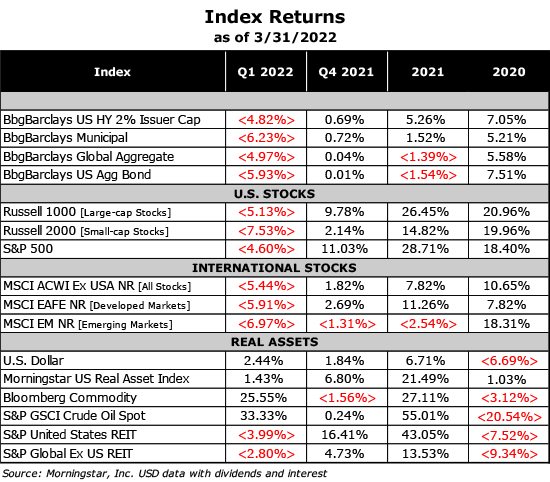
“I’m your boogie man, that’s what I am / I’m here to do whatever I can / Be it early morning, late afternoon / Or at midnight” KC and the Sunshine Band, “I’m Your Boogie Man”
Fans of the 2001 Pixar classic Monsters, Inc. will recall that there are indeed many bogeymen in the closet. Two years after the COVID-19 global shutdown, a new ‘monster’ has been introduced to investors and consumers: inflation. Headline inflation has reached levels not seen since the early 1980s, when CPI-measured inflation peaked near 15%. Contributing factors then included higher energy costs and led to a period of stagflation (rising costs and slowing growth). Then-new Fed chairman Paul Volcker believed that higher rates were necessary to combat rapidly rising inflation. The Fed began pushing rates higher, with the Fed Funds rate peaking at 20% (that’s not a typo) in March of 1980. Although inflation began to slow, two recessions resulted from the rate-hike decision. One source notes that “farmers protested at the Federal Reserve’s headquarters, and car dealers, who were especially affected by high interest rates, sent coffins containing the car keys of unsold vehicles. Many people also wrote letters to Volcker telling him how they had saved for many years to purchase a home but were now unable to because of high rates.”1 It should also be noted that the Fed increased the target Fed Funds rate from 15% to 20% in that March increase, an increase of 500 basis points (5%), again not a typo. This graph shows the 50-year history of inflation, including the high-inflation 1970s and 1980s, and historic averages:
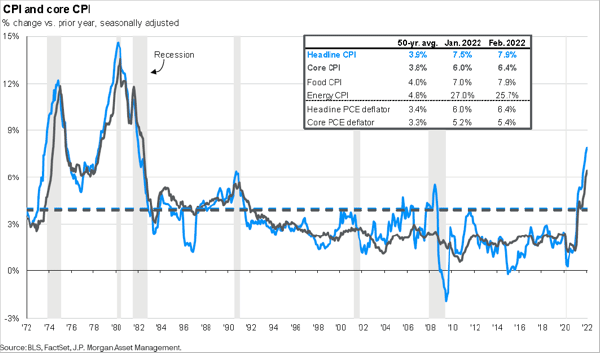
We can see that for much of the past 30-year period, headline CPI has been below the 50-year average, as has core CPI. These inflation levels have been definite tailwinds for consumers but have hurt savers and also employees due to low wage growth. This recent upward inflation spike has also seen a post-COVID rise in wages, which may lead to more inflation spirals.
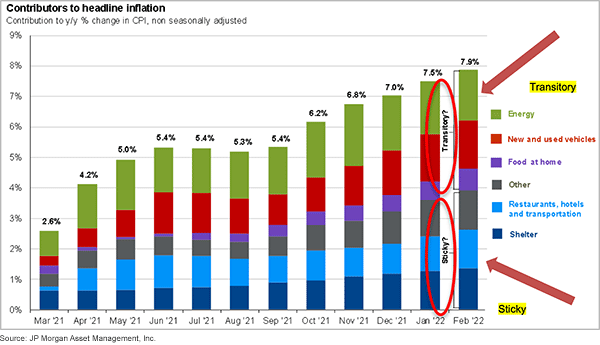
This graph details the changes in overall CPI and six key sectors for the past year. ‘Sticky’ inflation has been driven up by sharp changes in the leisure and shelter sectors, while ‘transitory’ inflation has been primarily pushed up by vehicles and energy costs. Softening in sticky data will help contain overall inflation, but geopolitics is contributing to changes in food and energy prices.
St. Louis Fed President James Bullard is comparing the Fed’s current policy course with the actions under former Fed chair Alan Greenspan in 1994. The sharp and nimble rate increase then, while painful, set the stage for strong economic and market rallies in the latter half of the decade. The transitory inflation increases referenced above reflect supply-chain issues for new and used cars (chip shortages), higher fuel costs (gasoline, heating fuel and jet fuel) and higher food costs. The sticky inflation increases include higher rent costs, and the leisure section (the light blue bars) reflects higher airline costs (fuel, labor and higher demand) as well as higher hotel costs. We see the need to balance the level and growth-rate of inflation with the extraordinary amount of demand in the economy due to the massive government fiscal infusion as well as delayed spending, especially on services. Forward inflation expectations indicate moderation to the 2.5% – 3.0% range five years out, implying that current levels of inflation are due to lessen. Timing is important, of course, and the economic effects of high inflation are not felt equally throughout the global economy. We still expect to see higher inflation for the immediate future, led by elevated fuel and food prices. The war in Ukraine has also affected prices. While U.S. oil supply is slowly rising, global output has fallen due to the war and Russia sanctions. Declining output of key agricultural commodities, specifically wheat (Ukraine is one of the largest exporters of wheat), and certain key industrial metals are also affected by the war.
“Control / Never gonna stop / Control / To get what I want / Control I like to have a lot” Janet Jackson, “Control”
The Fed has a dual mandate, managing to full employment and controlling inflation. As unemployment isn’t currently a major issue, the Fed has two methods by which it can tackle inflation: letting its balance sheet ‘run off’ and raising rates. The former option, which saw the Fed end its purchases of high-quality marketable bonds such as Treasurys and agency instruments in March, would remove a key buyer from the markets. The Fed would then let maturing securities ‘run off’ its balance sheet, effectively not replacing them with the proceeds from maturities and driving rates up. The latter option, rate increases, is more closely followed for future market and growth signals. The Fed has signaled that it expects to raise rates regularly and quickly to slam the brakes on inflation. The market originally expected several increases of 25 basis points (0.25%) for the rest of 2022, with increases continuing into 2023 and beyond. Expectations now are for more hikes in 2022 for a total of at least 1.75%, a much higher and faster rate than expected. This graph details the expected changes by Fed members (blue data), the market (green data) and long-run Fed expectations (purple):
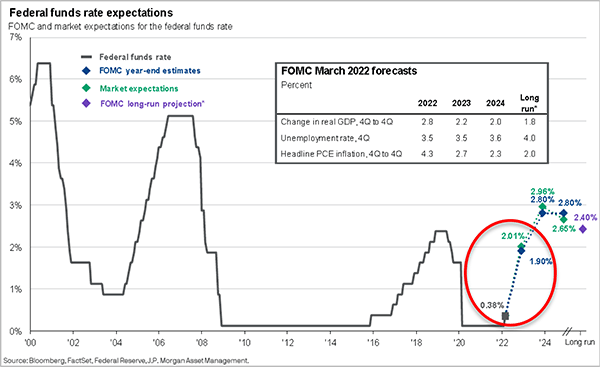
The data highlighted in red demonstrate the level and speed of expected rate changes. After starting the year at essentially zero, rates are expected to rise ~2.00% by the end of 2022. This would bring the target rate back to levels seen in 2019, before COVID. Increases may also be in 50 basis point (0.50%) increments rather than the conventional 25 basis points. This will likely lead to increased market volatility for stocks and bonds.
Traditionally, high-quality bonds—particularly U.S. Treasurys—have been a safe-haven ‘crisis asset’ in portfolios during periods of political upheaval or market disruption. As we see in the performance table at the top of this letter, that has not been the case thus far in 2022. Actual and expected rate increases have overshadowed equity-market and war concerns to have a negative impact on bonds, pushing yields and spreads higher. Fifteen years of monetary stimulus have had a very strong impact on equity-asset values (homes and stocks), but the rate-normalization policies the Fed should have begun earlier are now being forced into play to curb the decades-high rate of inflation. The expected safe haven during market drawdowns has thus been negatively tilted to reflect economic and higher-rate fears, resulting in very poor Q1-22 results that are worse than any single calendar year in the past 40 years. The following table summarizes the Bloomberg Aggregate’s performance by decade:

We can follow the long bull market in bonds from the 1980s through the 2010s as long rates declined after Chair Volcker’s 1980 hikes. Expectations for bonds going forward are for low, positive nominal returns as rates reset in the next few years.
“Like a bubble / Headed for trouble / Wind is blowing / In the wrong direction” Polly Brown, “Up in a Puff of Smoke”
Understanding the relationship between higher rates and stocks leads investors to ask, what’s going to happen to the stock market? As we saw above in the graph on interest-rate expectations, growth in the U.S. (and globally as well) is expected to slow to the pre-COVID range of 2% – 3% annually. The reasons for this include the evolving nature of productivity, ‘re-shoring’ global supply chains in favor of home-country production, higher inflation and increased workforce retirements. One factor that underpins many of these challenges is the ultimate disposition of all of the COVID stimulus money that entered the money supply over the past several years. If consumption flattens and sales revenues and margins come under pressure, investors might expect to see a decrease in earnings growth, especially as price and wage inflation shrink company income statements. As we believe stocks follow earnings, we would not expect the market to react well to these circumstances.
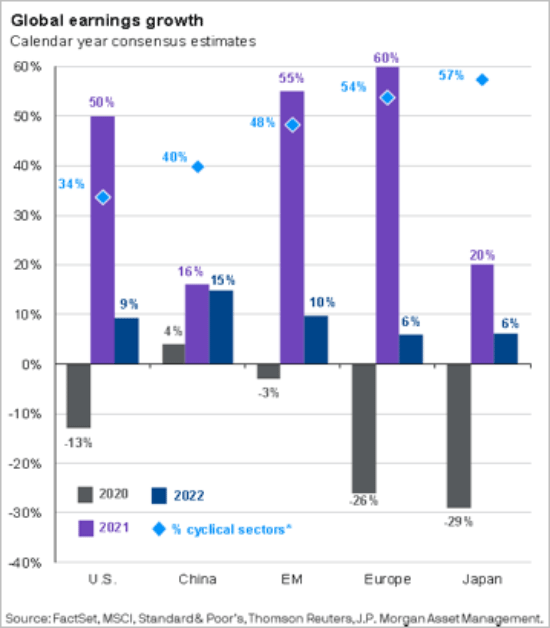
This graph details recent global-earnings growth results through early COVID with current-year estimates. (U.S. data are for the S&P 500.) Earnings were challenged in 2020 due to the global economic lockdown, but stocks quickly recovered and enjoyed favorable year-over-year comparisons in 2021, especially for energy and financial-services companies. For most regions except China, however, 2022 looks more moderate for earnings estimates for the reasons discussed above. Positive comparisons will be more difficult, and many firms that did well in 2020 and 2021 (e.g., technology and health-care names) found that the market was pricing in much higher growth than the companies were projecting or delivering. In a lower-growth environment, expect to see companies that miss estimates or offer weaker forward guidance to be punished for shortfalls.
“What you gonna do / When guests drop in on you? / We won’t go away / ‘Cause we’ve come out to stay” The Specials, “It’s Up to You”
We must also acknowledge the presence of our original bogeyman, the COVID virus that is still present and mutating around the globe. While last winter’s Omicron variant proved to be highly contagious, it was thankfully not as fatal as last year’s Delta variant or the original variant in 2020. Expectations are for another year of serious outbreaks of new variants as vaccines are re-formulated to deal with new strains. The current COVID strain, Omicron BA.2 (or ‘stealth Omicron’), is causing a rise in cases in some countries. China is mandating extreme lockdowns in Hong Kong, Shanghai and other parts of the country (even possibly Beijing) in an attempt to impose a zero-spread mandate, resulting in some negative economic effects and supply-chain disruptions. Health experts debate if this is the best solution to control the outbreak. It appears, however, that the COVID pandemic is moving to an endemic phase, i.e., it will be a persistent but manageable presence in the global environment that will require more frequent boosters. It is with disappointment that we note that global vaccine rollouts have been inconsistent, with more economically developed economies thus far having the lion’s share of vaccines. Under-vaccinated emerging economies may be particularly hard hit by rising interest rates and inflation and slowing global growth. The left graph below shows the history of the COVID waves in the U.S. over the past two years, and the right graph details the changes in some high-frequency economic data:
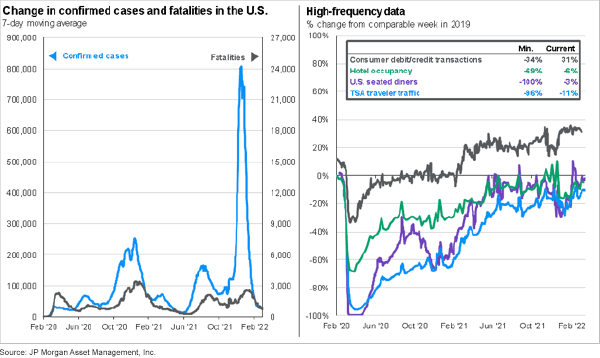
Of note in the right graph of frequency data is the recovery of dining and hotel reservations as well as the strong recovery in TSA traffic data. While not quite at pre-pandemic levels, these data highlight the strong economic recovery in the U.S. and bode well for future discretionary travel and entertainment spending. We do know that the U.S. has some of the better vaccination and immunity rates in the world, which bodes well for consumption and economic growth, especially to countries that allow cross-border travel.
“We pray, oh Lord Almighty / Protect our beloved Ukraine / Grant our people and country / All your kindness and grace” Ukrainian spiritual anthem, “God the Great One!”
Finally, to the real bogeyman. Russian Federation President Vladimir Putin’s illegal war on neighboring Ukraine has roiled global markets and politics. Putin’s ostensible reasons for invading Ukraine vary but were ultimately a play for control of an economically important European country. Successful control would bolster Russia’s agricultural and energy outputs, provide a buffer against NATO and imagined future ‘transgressions,’ and possibly begin the re-creation of the former Soviet empire. Ukraine’s brave resistance and Russia’s mounting military failures have affected the world both politically and economically. Issues to watch as this conflict unfolds include:
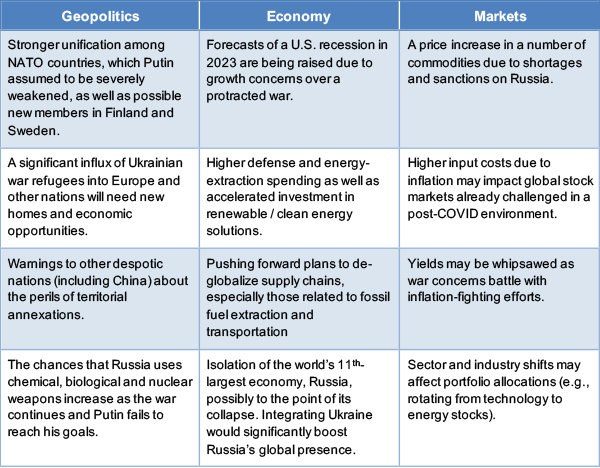
The outcome of the war is unknowable at this point. Ukraine’s strong resistance and battlefield success when facing a seemingly overrated and poorly performing Russian military portends a long war and an uneasy truce. Ukrainians are fighting bravely and refusing to surrender territory, promising a difficult path to peace. One certainty is that the economic fallout from the war will take time to be adapted to, and it’s unclear how shortages or oligarchic control over key economic inputs will affect inflation and markets.
“Some things in life are bad / They can really make you mad / Other things just make you swear and curse” Monty Python, “Always Look on the Bright Side of Life”
Our expectations are for increased volatility in both bonds and stocks in the coming months, as the Ukraine war exacerbates existing issues with post-COVID growth, inflation and the apparent end of long-term rate policies that kept rates near zero for many years. Recession forecasts are rising but aren’t expected to be realized for at least the next few quarters. One complication is that the Fed may not have the option to lower rates should a crisis occur as they are dedicated to raising rates to attempt a soft landing in their efforts to curb inflation.
We’ve highlighted a number of issues and one view of a worst-case scenario if the Pandora’s box list of concerns and fears all coalesced at once. That is certainly a probability, but not necessarily the largest one by any means. People and markets are adaptable and seek solutions, reminding us that the one thing Pandora left in the box when she closed it was hope. Hope by itself is not a reliable investment strategy, but it is something to embrace as investors work their way through a rough stretch, especially with respect to the war in Ukraine.
We recommend the following actions be taken now to mitigate some of the market challenges in this environment:
- Review your current expenses and any additional large expenditures you may have in the immediate future so that we may raise cash in your portfolio if required.
- Let us know if there any changes in your financial situation that we need to be aware of to determine if we need to adjust your asset allocation.
We expect the recent market volatility to continue for the foreseeable future. As always it is important to remember that investment-portfolio decisions should be long-term in nature, and short-term economic events should not dictate changes to your strategy. Many current market participants are new to investing and have never experienced a down-turn, and they will inevitably panic and sell good companies at low prices. Pull backs are very common and should be embraced as opportunities if you are a long-term investor. We remain committed to staying the course knowing that brighter days lay ahead once we get past the issues the economy and markets are confronting today.
Thank you for your confidence in us and as always, please contact us with your comments and questions.
—Your Wealth Management Team at JJ Burns & Company
Download Market Commentary
Disclosure: J.J. Burns & Company, LLC is a registered investment adviser with the U.S. Securities & Exchange Commission and maintains notice filings with the States of New York, Florida Pennsylvania, New Jersey, Connecticut, Georgia, Illinois, North Carolina, and California. J.J. Burns & Company, LLC only transacts business in states where it is properly registered, or excluded or exempted from registration. Follow-up and individualized responses to persons that involves either the effecting or attempting to effect transactions in securities, or the rendering of personalized investment advice for compensation, as the case may be, will not be made absent compliance with state investment adviser and investment adviser representative registration requirements, or an applicable exemption or exclusion.
All investing involves risk, including the potential for loss of principal. There is no guarantee that any investment plan or strategy will be successful.
The foregoing content reflects the opinions of J.J. Burns & Company, LLC and is subject to change at any time without notice. Content provided herein is for informational purposes only and should not be used or construed as investment advice or a recommendation regarding the purchase or sale of any security. There is no guarantee that the statements, opinions or forecasts provided herein will prove to be correct.
Past performance may not be indicative of future results. Indices are not available for direct investment. Any investor who attempts to mimic the performance of an index would incur fees and expenses which would reduce returns.
Securities investing involves risk, including the potential for loss of principal. There is no assurance that any investment plan or strategy will be successful.


